Kenneth L. Gentry Jr.'s Blog, page 44
July 27, 2021
PROBLEMS WITH THE EARLY DATE OF REVELATION (4)
 PMW 2021-058 by Kenneth L. Gentry, Jr.
PMW 2021-058 by Kenneth L. Gentry, Jr.
This is my final study of the leading objections to the early date. I am using Leon Morris, The Revelation of St. John (2d. ed.: Grand Rapids: Eerdmans, 1987) in considering the arguments.
The historical situations of the seven churches (Rev. 1:4; 2; 3), suggest a late date. Since these are historical churches to which John wrote, the letters may contain historical allusions helpful in dating Revelation. As Morris states it, the “indication is that the churches of Asia Minor seem to have a period of development behind them. This would scarcely have been possible at the time of the Neronic persecution, the only serious competitor in date to the Domitianic period” (Morris, 38). Mounce, Swete, Kümmel, Guthrie, and Beale employ the same argument.
Since I have not previously touched upon this evidence it deserves a little lengthier treatment. I will consider the four strongest arguments from this perspective, once again following the order found in Morris’s work on Revelation.
The Wealth of Laodicea (Rev. 3:17)
The first evidence Morris offers in this regard is drawn from Revelation 3:17: “Because you say, ‘I am rich, and have become wealthy, and have need of nothing,’ and you do not know that you are wretched anti miserable and poor and blind and naked.” Morris notes that in this letter the Laodicean church is spoken of as “rich,” but “a. the city was destroyed by an earthquake in AD 60/61 this must have been considerably later” (Morris, 38). All late-date advocates follow Morris’s approach.
Why I Left Full-Preterism (by Samuel M. Frost)
Former leader in Full Preterist movement, Samuel M. Frost, gives his testimony and theological reasoning as to why he left the heretical movement. Good warning to others tempted to leave orthodox Christianity.
See more study materials at: KennethGentry.com
According to Tacitus, Laodicea was destroyed by an earthquake about this time (Tacitus, Annals 4:27). The idea behind the argument is that such a devastating event as an earthquake necessarily must have severe and long-term economic repercussions on the community. And in such. a community, the minority Christians could be expected to have suffered, perhaps even disproportionately. If Revelation were written prior to A.D. 70, it is argued, the time frame would be insufficient to allow for the enrichment of the church at Laodicea. But by the time of Domitian a few decades later such would not be difficult to imagine.
Despite the initial plausibility of this argument it is not as strong as it appears. In the first place,
who is to say that the reference to “riches” mentioned by John is not a reference to spiritual riches? Alter all, such language is used in Scripture of those who glory in their presumed spiritual riches: Luke 12:21; 16:15; 18:11, 12; 1 Corinthians 1:5; 13:12; 2 Corinthians 8:9. In fact, this language is used in a way very similar to Revelation in 1 Corinthians 4:8 and Hosea 12:8. If the spiritual riches view is valid, then the entire force of the late-date argument would be dispelled. Surprisingly, this is even the view of late-date advocate Robert Mounce: “The ‘wealth’ claimed by the Laodicean church, however, was not material but spiritual.” And this despite the fact he uses the wealth of Laodicea as a late-date evidence. [1].
Second, fascinating historical evidence undermines the whole foundation of the late-date point, even if material riches are in view: Laodicea had a relatively effortless, unaided, and rapid recovery from the earthquake. Tacitus reports that the city did not even find it necessary to apply for an imperial subsidy to help them rebuild, even though such was customary for cities in Asia Minor. [2] Thus, despite the earthquake, economic resources were so readily available within Laodicea that the city easily recovered itself from the damage.
Third, who can say that the Christian community was necessarily overwhelmed by the quake in
that city? In Revelation 3:17 the church is in view, not the city. Even the horribly destructive earthquakes in Mexico City on September 19 and 20 of 1985 did not destroy every sector of the city. Perhaps, by the grace of God, the Christians were in areas less affected by the quake, as Israel was in an area of Egypt unaffected by the plagues (Ex. 8:22; 9:4, 6, 24; 10:23; 11:27). If the Laodicean church had been spared the effects of the quake, would this token of God’s providence lead the Laodiceans to a too proud confidence in their standing, as in Revelation 3:17? Perhaps a roughly analogous situation is found with the situation at Corinth, which Paul set about to correct (1 Cor. 4:6-8). Such boastful pride is ever a danger to those blessed of God (Deut. 8:18, cp. vv. 11-17).
Special Eschatology Studies (3 MP3 downloads)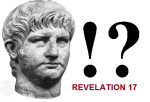
by Ken Gentry
Includes: (1) Radio interview on the Beast and Daniel 9: WMCA Radio (New York). (2) “The Beast is an Eighth,” a study on the tricky verse Rev 17:11 that is sometimes used to rebut the Neronic date for the writing of Revelation. (3) “The New Creation in Rev 21,” which presents a picture of the glory of the Christian faith as the spiritual phase of the New Creation that anticipates the consummate New Creation. See more study materials at: www.KennethGentry.com
The Existence of the Church in Smyrna
Morris’s second argument is that “the church at Smyrna seems not to have been in existence in the days of Paul” (Morris, 37). Obviously, if the church mentioned in Revelation 2:8-11 did not exist until after Paul’s death it could not have been founded before Paul’s martyrdom, which occurred in A.D. 67 or 68. Thus Revelation’s date could not precede A.D. 67/68. (It would not necessarily affect, however, a date after A.D. 67 and before A.D. 70)
This late-date objection is based on a statement by Polycarp in a letter written to the church at Philippi:
But I have neither perceived nor heard any such thing among you [i.e., the church at Philippi], among whom the blessed Paul laboured, who are praised in the beginning of his Epistle. For concerning you he boasts in all the churches who then alone had known the Lord, for we had not yet known him [1].
Polycarp (ca. A.D. 69-155), was the bishop of the church at Smyrna and is thought to have been the disciple of John. He seems to refer here to the Smyrnaeans church when he writes “we had not yet known him.” By this statement he may mean hi church at Smyrna was not yet founded while Paul was alive. Several late-date advocates consider this among their strongest arguments. Nevertheless, strong objections undermine its usefulness.
First, it is not at all necessary that Polycarp’s statement be interpreted in the manner demanded by Morris and others, i.e., as indicating that the church was founded after Paul died. Re-read the statement for yourself Does it demand that Paul was dead before the church at Smyrna was founded? Or could it easily be interpreted to mean that Paul praised the church at Philippi in his letter before the church at Smyrna was founded? It is much easier to understand Polycarp to be merely stating that Paul praised the Philippians for their conversion, which praise occurred before the Smyrnaeans were even converted. Polycarp would not then be saying that the Smyrnaeans church was founded after Paul died.
In the second place, most probably Smyrna was evangelized soon after Ephesus. We say this in light of the statements in Acts 19:10, 26. The Acts account emphasizes in conjunction with Paul’s labors in Ephesus, that “all who lived in Asia heard the word of the Lord Jesus” and that “in almost all of Asia” Paul was making progress in the promotion of the Gospel. Smyrna is one of the cities of Asia (Rev. 1:4, 11). If Smyrna was evangelized soon after Ephesus, then this would put Smyrna’s founding before the year 60. No necessity exists for assuming a late date for Revelation based on John’s letter to Smyrna and Polycarp’s letter to the Philippians.
The Spiritual Decline in Ephesus, Sardis, and Laodicea
The most familiar of the evidences from the Seven Letters is derived from warnings of spiritual decline at Ephesus, Sardis, and Laodicea. Obvious spiritual decline is noted in Revelation 2:4, 5; 3:1-2, 15-18. Morris states the late-date position thus: “All the churches in chapters ii and iii appear to have had a period of history. Especially is this the case with those of whom things could be said like ‘thou hast left thy first love’ (ii. 4)” (Morris 38).
Late-date theorists insist that the spiritual decline manifested in the churches demands a period of time more readily available if John wrote during Domitian’s reign. It seems a reasonable expectation that the early fervency of a newfound faith would wane only after the passing of various perils encountered over an extended period of time.
Despite all the vigorous assertions, however, a major objection destroys this argument: Granting a marked deterioration in the churches, the whole question of the length of time necessary for such lies at the heart of the situation. How long does it take for faith to wane? Was not Paul surprised at the rapid decline among the Galatians when he wrote: “I am amazed that you are so quickly deserting Him who called you by the grace of Christ, for a different gospel”?
Consider also Paul’s concern over the multitude of troubles within the church of Corinth. This church was founded in A.D. 49 and Paul wrote to it with heavy heart in A.D. 57. Apparently, Paul anticipated such problems among churches virtually as soon as he left the scene, as he noted to the elders of the church at Ephesus (Acts 20:29ff.). Was not Timothy urged to remain at Ephesus because of the entry of false doctrine within Paul’s lifetime (1 Tim. 1:6)?
Paul also experienced distressing defections from fidelity to him as a servant of Christ within his ministry (2 Tim. 4:10). Paul expresses concern over the labors of Archippus at Laodicea (one of the churches in question) when he warns him to “take heed to the ministry which you have received in the Lord, that you may fulfill it” (Col. 4:13-17).
How much more would such a problem of slackened zeal be aggravated by the political circumstances generated from the initiation of the Neronic persecution in A.D. 64? Did not Jesus’ teaching anticipates such (Matt. 13:20, 21; 24:9, 10)? No compelling reason whatsoever requires rejecting the early date of Revelation on the basis of the spiritual decline in certain of the Seven Churches. After considering this line of argument, late-date advocate Aune confesses: “Both lines of argument are capable of a variety of interpretations, so that a firm date late in the first century A.D. cannot be based on these arguments.” [2]
Conclusion
A careful consideration of the merits of the major arguments from the Seven Letters demonstrates their inconclusive nature. Neither the arguments individually, nor all of them collectively compels acceptance of the Domitianic date of Revelation. This is all the more obvious when their inconclusive nature is contrasted with the wealth of other internal considerations for an early date, as rehearsed heretofore in the present work.
In fact, the Seven Letters even have elements suggesting a period prior to the destruction of the temple: (1) The presence of strong Judaistic elements in the churches (Rev. 2:9; 3:9). This bespeaks an early period of Christian development prior to the cleavage between Jew and Christian in the A.D. 60s. (2) John’s exhortation to the churches anticipates the “judgment coming” of Christ (Rev. 2:5, 16; 3:3, 10). No events expected in Domitian’s day approached the magnitude and significance — either culturally or theologically — of the Neronic persecution, the death of Nero and the extinction of the Julio-Claudian imperial line, the destruction of Judaism’s temple, and the near demise of Rome in the Civil Wars of A.D. 68-69.
The early date stands, despite the attempted objections on the foregoing bases.
Notes
Polycarp, Letter to the Philippians 11:3.David Aune, Revelation 1-5, lxiiiJuly 23, 2021
PROBLEMS WITH REVELATION’S EARLY DATE (3)
 PMW 2021-057 by Kenneth L. Gentry, Jr.
PMW 2021-057 by Kenneth L. Gentry, Jr.
I am continuing a brief series on problems scholars have with the early (pre-AD 70) date of Revelation. I am using his Leon Morris’ book: The Revelation of St. John (2d. ed.: Grand Rapids: Eerdmans, 1987) as my main source. Let’s get to work!
A most unusual phenomenon seems to appear in Revelation, according to Morris. His third argument is very popular among late-date theorists. This evidence regards the very unusual and ancient legend known as the Nero Redivivus myth. Morris briefly explains the myth and confidently employs it: “Again, it is urged that the book shows evidence of knowledge of the Nero redivivus myth (e.g. xvii. 8, 11). After Nero’s death it was thought in some circles that he would return. At first this appears to have been a refusal to believe that he was actually dead. Later it took the form of a belief that he would come to life again. This took time to develop and Domitian’s reign is about as early as we can expect it” (Morris 37).
In providing the myth as late-date evidence David Aune boldly claims that “it is not likely that the Nero redivivus or Nero redux myth was widely circulated until the end of the first century A.D.”[1] In Moffatt’s commentary on Revelation 17 he speaks strongly of the myth’s role in interpreting the passage, when he noted that “the latter trait is unmistakably due to the legend of Nero redivivus, apart from which the oracle is unintelligible.” [2]
Nero so fearfully impressed the world in his era that pagan, Jewish, and Christian legends quickly sprang up around his death. These legends asserted themselves among the general populace throughout the far-flung reaches of the empire. In the pagan literature references to the expectation of Nero’s return after his fall from power may be found in the writings of Tacitus, Suetonius, Dio Cassius, Xiphilinus, Zonaras, and Dion Chrysostom. [3] Among the Jews the myth surfaces in the Talmud. In Christian circles :Lt is mentioned in books by Lactantius, Sulpicius Severus, Jerome, and Augustine. [4] Several Sibylline Oracles of various origins — Christian, Jewish, and pagan — use the myth as well. [5]
Greatness of the Great Commission (by Ken Gentry)
An insightful analysis of the full implications of the great commission. Impacts postmillennialism as well as the whole Christian worldview.
See more study materials at: www.KennethGentry.com
Interestingly, the myth was not simply a “wives’ tale” of little significance. It had a measurable impact even on political affairs. Pretenders to the imperial throne, claiming to be Nero used the myth in quests for power. [6].
Clearly the existence, spread, and influence of the Nero Redivivus myth cannot be disputed. It is one of the most fascinating and best-known legends in all of political history. But the questions with which we must deal are: Does the myth appear in Revelation? And if so, does this necessitate a late date for the composition of Revelation?
Despite the confidence with which some late-date advocates employ the Nero Redivivus myth, two intriguing facts arise in regard to its use by Biblical scholars.
First, not all late-date proponents allow the argument as helpful to the question of the dating of Revelation. Donald B. Guthrie, a most able late-date adherent, carefully considers the merits of the Nero Redivivus argument, but discourages its endorsement in the debate: “If then an allusion to the Nero myth is still maintained as underlying the language of Revelation xiii and xvii, it must be regarded as extremely inconclusive for a Domitianic date. The most that can be said is that it may possibly point to this.” [7] In fact, some admit it could arise soon after Nero’s death: “Given the presence of this legend, the Book of Revelation cold not have been written in its present form before 68 CE when Nero died, but the legend could have spread quickly after Nero’s death.” [8]
Second, a number of early date advocates believe the myth appears in Revelation, but still maintain the Neronic dating position. John A. T. Robinson is a case in point: “As virtually all agree, there must be a reference to Nero redivivus in the beast that ‘once was alive and is alive no longer but has yet to ascend out of the abyss before going to perdition.” [9]
It is most interesting to find proponents of both dating positions able to admit the presence of an element which the late-date school proffers as a leading proof for its position! Beyond these two initial problems, however; significant and reasonable possibilities available to hand wholly undermine the Nero Redivivus argument for a late date.
Despite the intriguing correspondences between the Nero Redivivus myth and some of Revelation prophecies, the two are not related. We may easily interpret the relevant passages in a way that has nothing whatsoever to do with the Nero Redivivus myth. In addition, this interpretation is more appropriate, not only in regard to one of the major events of the first century, but also to the theme of Revelation. What John is speaking about is not a myth, but the historical phenomena associated with the death of Nero, the near demise of Rome, and its reestablishment under Vespasian.
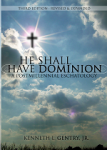
He Shall Have Dominion (Kindle version) by Kenneth Gentry
A classic, thorough explanation and defense of postmillennialism (600+ pages). Complete with several chapters answering specific objections.
See more study materials at: www.KennethGentry.com
Late-date proponent James Moffatt is particularly interesting at this point. He attempts to hold to the best of both worlds: (1) He vigorously attests that the Nero Redivivus myth appears in Revelation 13 and 17. He urges that its appearance helps establish the late date for Revelation, in that its highly developed form is not possible until Domitian’s reign (A.D. 81-96). [10] (2) But then he also adopts the interpretation of Revelation 13 and 17 like I suggest: That the death wound and revival of the beast refer to the Roman Civil Wars of A.D. 68-69. Notice his comments on Revelation 13:3:
The allusion is . . . to the terrible convulsions which in 69 A.D. shook the empire to its foundations (Tac Hist. i. 11). Nero’s death with the bloody interregnum after it, was a wound to the State, from which it only recovered under Vespasian. It fulfilled the tradition of the wounded head. . . . The vitality of the pagan empire, shown in this power of righting itself after the revolution, only added to its prestige. [11].
Thus, a vigorous late-date advocate and Nero Redivivus enthusiast admits that the references allude to the Roman Civil Wars and Rome’s revival under Vespasian. This is a telling admission. If the references in question can be applied to the Roman Civil Wars of A.D. 68-69, how can these same references point to Nero Redivivus and demand an A.D. 96 date for the book?
If the verses in Revelation can properly be understood as making reference to the earth-shaking historical events of the era, why would any commentator be driven to employ a myth to make sense of the passages? And this being the case, how can the myth be used as a major chronology datum from the internal evidence?
From our observations, it is obvious that the Nero Redivivus myth cannot be used with any degree of success to establish a late date for Revelation. There is good reason to doubt that it even appears in Revelation. The presumed evidence based on this myth cannot undermine the facts derived from the documented historical matters by which we may establish its early date.
Notes
David E. Aune, Revelation 1-5, lxi. See also: James Moffatt, Revelation, 317.James Moffatt, Revelation, 450.Tacitus, Historic 1:2; 2:8, 9; Suetonius, Nero 40, 57, Domitian 6; Dio Cassius, Roman History 63:9:3; 66:19:3; Xiphilinus 64:9; Zonaras, Annals 11:151-8; and Dion Chrysostom, Orations l.Lactantius, On The Death of the Persecutors 2; Sulpicius Severus, Sacred History 2:28; Jerome, Daniel 11:28; and Augustine, The City of God 20:19:3.Sibylline Oracles 3:63ff.; 4:1 15ff.; 5:33ff.; 8:68ff.; 12:78; 13:89ff.Tacitus, Histories 1:78; 2:8; Suetonius, Nero 57.Donald B. Guthrie, New Testament Introduction, 4th ed. (Downers Grove, Ill.: Inter-Varsity, 1990), 953.Leonard L. Thompson, The Book of Revelation: Apocalypse and Empire (New York: Oxford, 1990), 14.John A. T. Robinson, Redating the New Testament (Philadelphia: Westminster, 1976), 245. Moses Stuart and E. Earle Ellis are orthodox orthodox early-date scholars who allow that the myth appears in Revelation. Moses Stuart, Commentary on the Apocalypse (Andover: Allen, Morrill, Wardwell, 1845). E. Earle Ellis, The Making of the New Testament Documents (Boston: Brill, 1999), 212.Moffatt, Revelation, 317.Moffatt, Revelation, 430.Interestingly, Mounce does the same thing: On page 19 of his work, he employs the myth to demonstrate a late date for Revelation, but in his commentary at Revelation 13 and 17 he opts for the revival-of-the-Empire interpretation (Revelation, 248, 318).July 20, 2021
PROBLEMS WITH REVELATION’S EARLY DATE (2)
 PMW 2021-056 by Kenneth L. Gentry, Jr.
PMW 2021-056 by Kenneth L. Gentry, Jr.
Revelation’s early date is generally held by modern postmillennialists of the preterist variety. I have argued elsewhere positively for the early date. So here I am offering a short series that briefly responds to late-date evidences. I am focusing on Leon Morris’ arguments, due to their cogency, succinctness, and his stature as a Revelation commentator.
Morris discovers “indications that Revelation was written in a time of persecution.” This evidence is felt to accord “much better with Domitian.” [1] W. G. Kümmel is quite confident that “the picture of the time which the Apocalypse sketches coincides with no epoch of the primitive history so well as with the period of Domitian’s persecution.” [2] Morris, Kümmel, and a number of other scholars list this as among their leading arguments for the A.D. 95-96 date.
I agree that it seems clear enough that in Revelation imperial persecution against the faith has begun. But the evidence heavily favors a Neronic (A.D. 64-68) persecution rather than a Domitianic (A.D. 95-96) one. In fact, it is extremely difficult to even prove a Domitianic persecution — secular history is totally silent on the possibility.
Surprisingly, when we turn to Morris’s own presentation, we are frustrated as we seek sure conviction: “While later Christians sometimes speak of a persecution under Domitian the evidence is not easy to find.” [3] Many scholars understand Domitian’s violent conduct in A.D. 95 as a paranoid outburst. [4] It seemed to concentrate on “selected individuals whom he suspected of undermining his authority.” [5] The problem with the evidence for this “persecution” is that it proceeds solely from Christian sources — sources somewhat later than the events. A Domitianic persecution is not mentioned by any secular historian of the era.

Before Jerusalem Fell Lecture (DVD)
DVD by Ken Gentry
A summary of the evidence for Revelation’s early date. Helpful, succinct introduction to Revelation’s pre-AD 70 composition.
See more study materials at: www.KennethGentry.com
Though the historicity of a Domitianic persecution of Christianity is questioned, such cannot be the case with the persecution under Nero. Although many scholars argue that the Neronic persecution was confined to Rome and its environs, the indisputable fact remains: Nero cruelly persecuted Christianity, taking even the lives of its foremost leaders, Peter and Paul. The evidence for the Neronic persecution is overwhelming and is documentable from heathen, as well as Christian, sources.
In Before Jerusalem Fell I showed clear evidence of a Neronic persecution from the writings of several pagan and Christian writers of the era. To that list let me now add Tertullian (A.D. 150-220), who was a lawyer who wrote in Latin, the legal language of the Roman Empire. In defending Christianity, he challenged men to search the archives of Rome for the proof that Nero persecuted the Church: “Arid if a heretic wishes his confidence to rest upon a public record, the archives of the empire will speak, as would the stones of Jerusalem. We read the lives of the Caesars: “At Rome Nero was the first who stained with blood the rising faith.” [6] Surely he would not issue a challenge to search the archives of Rome, which could easily be taken and just as easily refuted, were his statement untrue.
 Keys to the Book of Revelation
Keys to the Book of Revelation
(DVDs by Ken Gentry)
Provides the necessary keys for opening Revelation to a deeper and clearer understanding.
See more study materials at: www.KennethGentry.com
Indisputably, the sheer magnitude, extreme cruelty, and paradigmatic role of Nero’s persecution of Christianity fit well the role required in Revelation. Thus, we are led again to repeat: The Domitianic evidence is doubtful and, if accepted at all, pales in comparison to Nero’s. Interestingly, late-date advocate Robert Mounce, like so many others, admits that “the evidence for widespread persecution under Domitian is not especially strong.” Yet, he goes on rather boldly to add that “there is no other period in the first century in which it would be more likely”! [7] No other period?
The late-date use of the persecution theme in Revelation can neither establish the late date for Revelation, nor compete with the early date evidences.
Notes
Morris, Revelation, 37.W. G. Kümmel, Introduction to the New Testament, trans. Howard Clark Kee, 17th ed. (Nashville: Abingdon, 1973), 328.Morris, Revelation, 36For example, J. Ramsey Michaels, Revelation (IVPNTC) (Downers Grove, Ill.: InterVarsity Press, 1997), 19. M. Eugene Boring, Revelation: Interpretation: A Bible Commentary for Teaching and Preaching (Louisville: John Knox, 1989), 17.Glenn W. Barker, William L. Lane, and J. Ramsey Michaels, The New Testament Speaks (New York: Harper and Row, 1969), 368.Tertullian, Scorpion’s Sting 15.Robert Mounce, The Book of Revelation (2d. ed.: Grand Rapids: Eerdmans, 1998), 34.July 17, 2021
PROBLEMS WITH REVELATION’S EARLY DATE (1)
Objections, Preterism, Revelation July 16, 2021 Comments: 3

PMW 2021-055 by Kenneth L. Gentry, Jr.
Preteristic postmillennialists hold that Revelation was written prior to the destruction of Jerusalem and the temple in AD 70. We argue this on historical and exegetical grounds. We do not argue for an early date for Revelation on purely theological grounds in order to defend our long-range hope against John’s enormous judgment scenes.. I have argued the case of the early date of Revelation in several places, most especially in my doctoral dissertation published as Before Jerusalem Fell. In this brief series of articles I will respond to four leading arguments against the early date.
The modern case for the late date of Revelation concentrates upon four basic arguments. These have been ably and succinctly summarized by noted evangelical scholar and late-date advocate Leon Morris in his commentary, The Revelation of St. John (2d. ed.: Grand Rapids: Eerdmans, 1987). I choose to investigate Morris’s approach for three basic reasons.
(1) He has rightfully earned an international reputation among both evangelical and liberal scholars. (2) He has a demonstrated competence in the field of New Testament studies, having even produced an excellent commentary on Revelation itself. (3) His presentation is succinct and focused, which lends itself to blog analysis. The order of my listing of these evidences will follow Morris’s, which is based on his scholarly estimation of their priority.
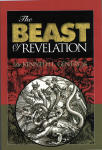
The Beast of Revelation
by Ken Gentry
A popularly written antidote to dispensational sensationalism and newspaper exegesis. Convincing biblical and historical evidence showing that the Beast was the Roman Emperor Nero Caesar, the first civil persecutor of the Church. The second half of the book shows Revelation’s date of writing, proving its composition as prior to the Fall of Jerusalem in A.D. 70. A thought-provoking treatment of a fascinating and confusing topic.
For more study materials, go to: KennethGentry.com
Morris begins with what he calls “the principal reason for dating the book during” Domitian’s reign, which is: Revelation “contains a number of indications that emperor-worship was practised, and this is thought to have become widespread in Domitian’s day” (p. 35).Earlier than Morris, James Moffatt insisted that the role of emperor worship in Revelation was virtually conclusive: “When the motive of the Apocalypse is thus found in the pressure upon the Christian conscience exerted by Domitian’s emphasis on the imperial cultus, especially as that was felt in Asia Minor, any earlier date for the book becomes almost impossible.” [1]
This argument regarding emperor worship is also held by Robert H. Mounce, R. H. Charles, H. B. Swete, Donald B. Guthrie, W. G. Kümmel, M. Eugene Boring, William Barclay, and many others. References in Revelation which seem to reflect emperor worship are found in scattered places. See especially Revelation 13:4, 8, 12, 15; 14:9, 11; 16:2; 19:20; 20:4. The most noteworthy statements re found in Revelation 13, where worship of the “beast” is compelled.
Unfortunately, for this view emperor worship dates back to Julius Caesar in the last century before Christ. And it is endorsed by Nero, the emperor who commissions Vespasian to put down the Jewish rebellion (which results in the destruction of the temple). The emperor cult had a prominent role in the political and social life of the Roman empire well before Domitian, and even before Nero.
Although it is true that historical development continued to introduce new features and requirements into the practice, nevertheless after 30 B.C. “we can observe a swift spread of the emperor cult throughout the Roman Near East.” [2] As even late-date advocate James Moffatt wrote: “The blasphemous title of dims, assumed by the emperors since Octavian (Augustus = sebastos) as a semi-sacred title, implied superhuman claims which shocked the pious feelings of Jews and Christians alike. So did theos [god] and theou huios [son of god] which, as the inscriptions prove, were freely applied to the emperors, from Augustus onwards.” [3]

Before Jerusalem Fell Lecture (DVD)
DVD by Ken Gentry
A summary of the evidence for Revelation’s early date. Helpful, succinct introduction to Revelation’s pre-AD 70 composition.
See more study materials at: www.KennethGentry.com
The appearance of emperor worship in Revelation is held by many late-date theorists as the strongest evidence for a date during the last year of the reign of Domitian (A.D. 81-96). It is true that Domitian required people to address him as “Lord and God.” Certainly the emperor cult was prominent in his reign. Yet when we scrutinize the relevant historical evidence we discover abundant testimony to emperor worship at various stages of development well before both Domitian and Nero. Indeed, such clear statements exist of so many aspects of the emperor cult, it is surprising that this argument is used at all against the early date. One wonders why it is deemed “the principal reason” (Morris) that makes it “almost impossible” (Moffatt) for the early date view to stand is wholly incredible.
Notes
James Moffatt, The Revelation of St. John the Divine, vol. 5 in W. Robertson Nicoll, ed., The Expositor’s Greek Testament (Grand Rapids: Eerdmans, rep. 1980), 317.Doron Mendels, The Rise and Fall of Jewish Nationalism: Jewish and Christian Ethnicity in Ancient Palestine (Grand Rapids: Eerdmans, 1992), 278.Moffatt, Revelation, 429. See also: Aune, Revelation 1-5, lxviii; Leonard L. Thompson, The Book of Revelation: Apocalypse and Empire (New York: Oxford, 1990), 104-190.July 16, 2021
PROBLEMS WITH REVELATION’S EARLY DATE (1)
 PMW 2021-055 by Kenneth L. Gentry, Jr.
PMW 2021-055 by Kenneth L. Gentry, Jr.
Preteristic postmillennialists hold that Revelation was written prior to the destruction of Jerusalem and the temple in AD 70. We argue this on historical and exegetical grounds. We do not argue for an early date for Revelation on purely theological grounds in order to defend our long-range hope against John’s enormous judgment scenes.. I have argued the case of the early date of Revelation in several places, most especially in my doctoral dissertation published as Before Jerusalem Fell. In this brief series of articles I will respond to four leading arguments against the early date.
The modern case for the late date of Revelation concentrates upon four basic arguments. These have been ably and succinctly summarized by noted evangelical scholar and late-date advocate Leon Morris in his commentary, The Revelation of St. John (2d. ed.: Grand Rapids: Eerdmans, 1987). I choose to investigate Morris’s approach for three basic reasons.
(1) He has rightfully earned an international reputation among both evangelical and liberal scholars. (2) He has a demonstrated competence in the field of New Testament studies, having even produced an excellent commentary on Revelation itself. (3) His presentation is succinct and focused, which lends itself to blog analysis. The order of my listing of these evidences will follow Morris’s, which is based on his scholarly estimation of their priority.
The Beast of Revelation
by Ken Gentry
A popularly written antidote to dispensational sensationalism and newspaper exegesis. Convincing biblical and historical evidence showing that the Beast was the Roman Emperor Nero Caesar, the first civil persecutor of the Church. The second half of the book shows Revelation’s date of writing, proving its composition as prior to the Fall of Jerusalem in A.D. 70. A thought-provoking treatment of a fascinating and confusing topic.
For more study materials, go to: KennethGentry.com
Morris begins with what he calls “the principal reason for dating the bock during” Domitian’s reign, which is: Revelation “contains a number of indications that emperor-worship was practised, and this is thought to have become widespread in Domitian’s day” (p. 35).Earlier than Morris, James Moffatt insisted that the role of emperor worship in Revelation was virtually conclusive: “When the motive of the Apocalypse is thus found in the pressure upon the Christian conscience exerted by Domitian’s emphasis on the imperial cultus, especially as that was felt in Asia Minor, any earlier date for the book becomes almost impossible.” [1]
This argument regarding emperor worship is also held by Robert H. Mounce, R. H. Charles, H. B. Swete, Donald B. Guthrie, W. G. Kümmel, M. Eugene Boring, William Barclay, and many others. References in Revelation which seem to reflect emperor worship are found in scattered places. See especially Revelation 13:4, 8, 12, 15; 14:9, 11; 16:2; 19:20; 20:4. The most noteworthy statements re found in Revelation 13, where worship of the “beast” is compelled.
Unfortunately, for this view emperor worship dates back to Julius Caesar in the last century before Christ. And it is endorsed by Nero, the emperor who commissions Vespasian to put down the Jewish rebellion (which results in the destruction of the temple). The emperor cult had a prominent role in the political and social life of the Roman empire well before Domitian, and even before Nero.
Although it is true that historical development continued to introduce new features and requirements into the practice, nevertheless after 30 B.C. “we can observe a swift spread of the emperor cult throughout the Roman Near East.” [2] As even late-date advocate James Moffatt wrote: “The blasphemous title of dims, assumed by the emperors since Octavian (Augustus = sebastos) as a semi-sacred title, implied superhuman claims which shocked the pious feelings of Jews and Christians alike. So did theos [god] and theou huios [son of god] which, as the inscriptions prove, were freely applied to the emperors, from Augustus onwards.” [3]
Before Jerusalem Fell Lecture (DVD)
DVD by Ken Gentry
A summary of the evidence for Revelation’s early date. Helpful, succinct introduction to Revelation’s pre-AD 70 composition.
See more study materials at: www.KennethGentry.com
The appearance of emperor worship in Revelation is held by many late-date theorists as the strongest evidence for a date during the last year of the reign of Domitian (A.D. 81-96). It is true that Domitian required people to address him as “Lord and God.” Certainly the emperor cult was prominent in his reign. Yet when we scrutinize the relevant historical evidence we discover abundant testimony to emperor worship at various stages of development well before both Domitian and Nero. Indeed, such clear statements exist of so many aspects of the emperor cult, it is surprising that this argument is used at all against the early date. One wonders why it is deemed “the principal reason” (Morris) that makes it “almost impossible” (Moffatt) for the early date view to stand is wholly incredible.
Notes
James Moffatt, The Revelation of St. John the Divine, vol. 5 in W. Robertson Nicoll, ed., The Expositor’s Greek Testament (Grand Rapids: Eerdmans, rep. 1980), 317.Doron Mendels, The Rise and Fall of Jewish Nationalism: Jewish and Christian Ethnicity in Ancient Palestine (Grand Rapids: Eerdmans, 1992), 278.Moffatt, Revelation, 429. See also: Aune, Revelation 1-5, lxviii; Leonard L. Thompson, The Book of Revelation: Apocalypse and Empire (New York: Oxford, 1990), 104-190.July 13, 2021
IS AMILLENNIALISM PESSIMISTIC?
 PMW 2021-054 by Kenneth L. Gentry, Jr.
PMW 2021-054 by Kenneth L. Gentry, Jr.
The basic evangelical eschatological positions may be broken down into two classes: optimistic or pessimistic. Only postmillennialism is characterized as optimistic. In fact, this is the distinctive feature of postmillennialism, which resembles amillennialism in most other respects.
Amillennialists do not like being deemed pessimistic. And they will often complain that postmillennialists wrongly designate them as “pessimistic.” They generally reject this evaluation for two reasons: (1) It is negative sounding in itself, and (2) it overlooks the fact that they argue that ultimately Christ and his people win the victory at the end of history. Still other amillennialists deny this designation because they call themselves “optimistic amillennialists.”
But why do postmillenialists argue that amillennialism is “pessimistic”? What is it about their system that distinguishes them from postmillennialism regarding this optimism/pessimism issue?
He Shall Have Dominion
(paperback by Kenneth Gentry)
A classic, thorough explanation and defense of postmillennialism (600+ pages). Complete with several chapters answering specific objections.
See more study materials at: www.KennethGentry.com
Of course, all evangelical eschatological perspectives are ultimately optimistic by the very nature of evangelical theology. Christ does lead his people to victory in saving them from their sins, resurrecting them from the dead, and establishing them in righteousness in the eternal order. These issues are not debated among evangelicals: Christianity inherently has glorious, eternal consequences.
Nevertheless, these issues are irrelevant to debate between the millennial views.
Historically amillennialism has tended to be pessimistic in terms of the question of widespread, long-lasting cultural success for the Christian faith in time and on earth. That is, regarding these matters:
First, as a system of gospel proclamation amillennialism teaches that the gospel of Christ will not exercise any majority influence in the world before Christ’s return. They allow that Christianity may enjoy flashes of revival and spurts of growth. Yet, by its very nature the amillennial system cannot allow that Christianity will become the dominant feature of human society and culture.
Second, as a system of historical understanding amillennialism, in fact, holds the Bible teaches there are prophetically determined, irresistible trends downward toward chaos in the outworking and development of history. Though some amillennialists understand the great tribulation in the Olivet Discourse as referring (correctly) to the Jewish War and the AD 70 destruction of the temple, their system necessarily demands a prophetically-determined collapse of society in history.
Three Views on the Millennium and Beyond
(ed. by Darrell Bock)
Presents three views on the millennium: progressive dispensationalist, amillennialist, and reconstructionist postmillennialist viewpoints. Includes separate responses to each view. Ken Gentry provides the postmillennial contribution.
See more study materials at: www.KennethGentry.com
Third, as a system for the promotion of Christian discipleship amillennialism dissuades the Church from anticipating and laboring for wide-scale success in influencing the world for Christ during this age. In fact, this distinguishes amillennialism and postmillennialism. Regarding the question of so-called “optimistic amillennialists,” it seems to me that the verses an amillennialist would use to underscore his optimism are those that endorse a postmillennial perspective. Unless, of course, he is optimistic on grounds other than direct biblical revelation. Therefore, he should come out of the closet and be a postmillennialist.
July 9, 2021
WHY WILL SATAN BE LOOSED?
 PMW 2021-053 by Kenneth L. Gentry, Jr.
PMW 2021-053 by Kenneth L. Gentry, Jr.
I continue to receive this question on a regular basis. So I thought it a good idea to re-visit it.
In Rev 20 John focuses briefly on ultimate eschatological events that look well beyond the short time frame of the book. This is anticipated in his referring to the thousand years (Rev 20:2, 3, 4, 5, 6, 7), which by definition must extend beyond the “near” / “at hand” time frame. “Now, although the closing part of the Revelation relates beyond all doubt to a distant period, and some of it to a future eternity, yet the portion of the book which contains this is so small, and that part of the book which was speedily fulfilled is so large, that no reasonable difficulty can be made concerning” the book’s claim to focus on near-term events” (Moses Stuart, Apocalypse, 2:5).
But you may ask why Satan will be loosed. You will have to ask John, not me — for he does not say. Just as God surprisingly allows Satan to enter Eden and tempt Adam and Eve, so does he allow Satan’s re-release to tempt the nations live for a long time under Christ’s rule (cf. G. R. Beasley-Murray, Revelation, 291).
John does indicate, though, that Satan “must [dei] be released” (Rev 20:3d): it is God’s will (cp. dei, Rev 1:1; 4:1; 10:11; 11:5; 17:10; 22:6). Satan does not escape his captivity, he is “released.” Note that luthēsetai is in the passive voice, which is almost invariably associated with divine activity in Rev (cp. 20:3). H. B. Swete (Apocalypse, 261) declares that “it is in vain to speculate on the grounds of this necessity.” Mounce (Revelation, 363) states that it is “futile to speculate” why another war (the consequence of Satan’s release) is necessary. As J. M. Kik (The Eschatology of Hope, 237) well observes: why the Lord releases Satan “is within the secret counsel of the Godhead.” John states only the historical fact of Satan’s release, not the divine reason.
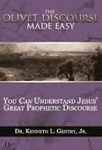
Olivet Discourse Made Easy (by Ken Gentry)
Verse-by-verse analysis of Christ’s teaching on Jerusalem’s destruction in Matt 24. Show the great tribulation is past, having occurred in AD 70.
See more study materials at: www.KennethGentry.com
This fact of Satan’s release embarrasses the premillennialist’s literalistic scheme (especially the classic dispensationalist variety), for it results in a second humiliation for Christ after his glorification (Kik, Eschatology, 237): Satan “will come out to deceive the nations which are in the four quarters of the earth, Gog and Magog, to gather them together for the war” (Rev 20:8b). Here Satan is leading nations to rebel against Christ’s personal, direct, ages-long rule (Rev 20:4–6).
What is more, on the literalist scheme they actually surround Christ and his glorified saints, holing them up in Jerusalem (Rev 20:9). Literalist Thomas (Revelation 2:425) notes that in this episode (Rev 20:8–9) John speaks of “the land of Palestine as being fully occupied by these attacking forces,” including the surrounding of Jerusalem which “will be the location of the Messiah’s throne.” Walvoord (Bible Knowledge Commentary, 1985:980) agrees: “Satan’s release will produce a worldwide rebellion against the millennial reign of Christ. The armies will be so vast in numbers that they are said to be ‘like the sand on the seashore.’”
John’s scene does not pose a problem for other evangelical viewpoints, for they do not have the exalted Christ living on earth for 1000 years and being surrounded by rebellious hordes.
We should not understand this whole scene in 20:7–9 literally, as if God’s kingdom is headquartered in historical Jerusalem and can actually be surrounded. Rather, it presents in militaristic imagery an end-time apostasy of the nations from the long dominance of Christianity. Though John draws his images from Ezekiel, which does seem to refer to actual military engagements, we see once again his departure from Ezekiel for “John thought and acted for himself” (Stuart Apocalypse, 2:367).
Four Views on the Book of Revelation
(ed. by Marvin Pate)
Helpful presentation of four approaches to Revelation. Ken Gentry writes the chapter on the preterist approach to Revelation, which provides a 50 page survey of Revelation .
See more study materials at: www.KennethGentry.com
Regarding the reason, perhaps Terry (Biblical Apocalyptics, 455) captures the significance of this event:
“These verses 7–10 depict the last great struggle of Satan and his forces to overcome the saints of God, and their overwhelming defeat before the manifested power of heaven. The obvious purpose is to show the final and decisive victory of the seed of the woman over their ancient foe. It is a great symbolic picture, and its one great teaching is clear beyond the possibility of doubt, or misunderstanding, namely, that Satan and his foes must ultimately perish. . . . That final victory is in the far future, at the close of the Messianic age, and it is here simply outlined in apocalyptic symbols.”
July 6, 2021
THE TEMPLE IN REVELATION 11
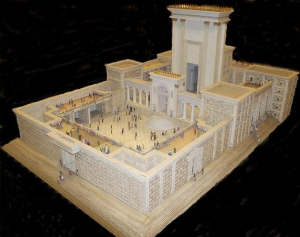 PMW 2021-052 by Kenneth L. Gentry, Jr.
PMW 2021-052 by Kenneth L. Gentry, Jr.
Revelation is an important book in eschatological discussions. The most vigorous Revelation debate in ecclesiastical circles today revolves around the dispute between preterism and futurism. Preterism holds that Revelation was largely fulfilled not long after John wrote it. Futurism holds that it deals largely with events yet to come.
Because of this debate, the identity of the temple in Rev 11 arises as a serious matter. In Revelation 11:1, 2 we read:
And there was given me a reed like unto a rod: and the angel stood, saying, Rise, and measure the temple of God, and the altar, and them that worship therein. But the court which is without the temple leave out, and measure it not; for it is given unto the Gentiles: and the holy city shall they tread under foot forty and two months.
Here we find a Temple standing in a city called “the holy city.” Surely John, a Christian Jew, has in mind historical Jerusalem when he speaks of “the holy city.” This seems necessary in that John is writing scripture and Jerusalem is frequently called the “holy city” in the Bible. For example: Isaiah 48:2; 52:1; Daniel 9:24; Nehemiah 11:1-18; Matthew 4:5; 27:53.
In addition, verse 8 informs us that this is the city where “also our Lord was crucified.” This was historical Jerusalem, according to the clear testimony of Scripture (Luke 9:22; 13:32; 17:11; 19:28). Interestingly, historical Jerusalem is never mentioned by name in Revelation. This may be due to the name “Jerusalem” meaning “city of peace.” In Revelation the meanings of specific names are important to the dramatic imagery. And so it would be inappropriate to apply the name “Jerusalem” to the city upon which woe and destruction are wreaked.
Before Jerusalem Fell (Kindle version) (by Ken Gentry)
Doctoral dissertation defending a pre-AD 70 date for Revelation’s writing. Thoroughly covers internal evidence from Revelation, external evidence from history, and objections to the early date by scholars.
See more study materials at: www.KennethGentry.com
Now what Temple stood in Jerusalem? Obviously the Jewish Temple ordained of God, wherein the Jewish sacrifices were offered. In the first century it was known as Herod’s Temple. This reference to the Temple must be that historical structure for four reasons:
(1) It was located in Jerusalem, as the text clearly states in verse 8. This can only refer to
the Herodian Temple, which appears over and over again in the New Testament record. It was the very Temple which was even the subject of one of Christ’s longer prophetic discourses (Matt. 23:37-24:2ff).
(2) Revelation 11:1, 2, written by the beloved disciple and hearer of Christ, seems clearly to draw upon Jesus’ statement from the Olivet Discourse. In Luke 21:5-7, the disciples specifically point to the Herodian Temple to inquire of its future; in Revelation 11:1 John specifically speaks of the Temple of God. In Luke 21:6 Jesus tells his disciples that the Temple will soon be destroyed stone by stone. A comparison of Luke 21:24 and Revelation 11:2 strongly suggests that the source of Revelation’s statement is Christ’s word in Luke 21.
• Luke 21:24b: “Jerusalem will be trampled underfoot by the Gentiles until the times of the Gentiles be fulfilled.”
• Revelation 11:2b: “it is given unto the Gentiles: and the holy city shall they tread under foot for forty and two months.”
The two passages speak of the same unique event and even employ virtually identical terms.
(3) According to Revelation 11:2 Jerusalem and the Temple were to be under assault for a period of forty-two months. We know from history that the Jewish War with Rome was formally engaged in Spring, A.D. 67, and was won with the collapse of the Temple in August, A.D. 70. This is a period of forty-two months, which fits the precise measurement of John’s prophecy. Thus, John’s prophecy antedates the outbreak of the Jewish War.
Four Views on the Book of Revelation
(ed. by Marvin Pate)
Helpful presentation of four approaches to Revelation. Ken Gentry writes the chapter on the preterist approach to Revelation, which provides a 50 page survey of Revelation .
See more study materials at: www.KennethGentry.com
(4) After the reference to the destruction of the “temple of God” in the “holy city,” John later speaks of a “new Jerusalem” coming down out of heaven, which is called the “holy city” (Rev. 21:2) and which does not need a temple (Rev. 21:22). This new Jerusalem is apparently meant to supplant the old Jerusalem with its temple system. The old order Temple was destroyed in August, A.D. 70.
Thus, while John wrote, the Temple was still standing, awaiting its approaching doom. If John wrote this twenty-five years after the Temple’s fall it would be terribly anachronous. The reference to the Temple is hard architectural evidence that gets us back into an era pre-A.D. 70.
July 2, 2021
THE NT AND POSTMILLENNIALISM
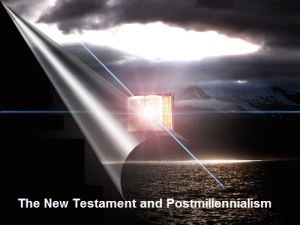 PMW 2021-051 by Kenneth L. Gentry, Jr.
PMW 2021-051 by Kenneth L. Gentry, Jr.
As we enter the New Testament record Christ’s birth immediately confronts us. The birth of “the Son of David, the Son of Abraham” (Mt 1:1) gloriously echoes the Old Testament victory theme, showing that his first coming begins the fruition of the promises (Lk 1:46–55, 68–79). The fullness of time comes in the first century through Christ’s incarnation (Gal 4:4; Eph 1:10; Tit 1:2–3).
Christ’s covenanted kingdom comes near in his early ministry because the “time was fulfilled” for it to come (Mk 1:14–15; Mt 3:2). Thus, John Baptist is something of a marker separating the fading Old Testament era from the dawning kingdom era (Mt 11:11–14; Mk 1:14–15; Jn 3:26–30).
During his earthly ministry we witness Christ’s power over demons as evidence that the kingdom has come (Mt 12:28). It does not await his second advent (Lk 17:20–21), for as he preaches the gospel, he claims to be king while on earth (Jn 12:12–15; 18:36–37). Following his resurrection and ascension, Pentecost becomes the celebration of his enthronement in heaven (Ac 2:30–36). From then on we hear of his being in a royal position at the right hand of Almighty God (Mk 16:19; Ro 8:34; Eph 1:20; 1Pe 3:22; Rev 3:21).
Because of this, first-century Christians proclaim him as a king (Ac 3:15; 17:7; Rev 1:5) possessing regal dignity, authority, and power (Eph 1:22; Php 2:9). Beginning in the first century people at conversion enter into the kingdom of Christ (Col 1:12, 13; 4:11; 1Th 2:12). Christ’s kingdom rule goes where his people go, for they are the subjects of his kingdom (Rev 1:6, 9) and are now mystically seated with him in a rulership position (Eph 1:3; 2:6; 1Co 3:21–22; Rev 3:21).
He Shall Have Dominion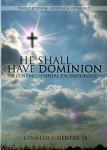
(paperback by Kenneth Gentry)
A classic, thorough explanation and defense of postmillennialism (600+ pages). Complete with several chapters answering specific objections.
See more study materials at: www.KennethGentry.com
The actual starting point of Christ’s kingly victory is at his resurrection from the dead (Mt 28:18–20; Ac 2:30–31; Ro 1:3–4) and his ascension to God’s right hand (Da 7:13–14, 27; Lk 22:69; 24:46–53). Celebrating his cosmic victory over sin, death, and Satan, he pours out his Spirit to empower his faithful subjects for kingdom service (Ac 2:32–33; Eph 4:8).
Christ’s kingdom is essentially spiritual in nature (Jn 18:36–37; Ro 14:17) and operates from within the heart (Lk 17:20–21). We enter his kingdom through salvation (Col 1:12, 13; Jn 3:3). He rules his kingdom by his mystical presence from heaven (Jn 18:36; Eph 4:8–14) and through the indwelling of the Holy Spirit (Jn 7:39; Ro 8:9; 1Co 3:16). The basic power of the kingdom is the “gospel of the kingdom” (Mt 4:23; 9:35; Mk 1:14–15), for it is the power of God unto salvation (Ro 1:16; 1Co 1:18; 2Co 6:7). The basic function of the kingdom is to promote God’s truth (Jn 18:37; 2Co 10:4–5).
The kingdom is not a future, Armageddon-introduced, earthly, political kingdom. By misreading Scripture, the first-century Jews seek a political kingdom to overthrow Rome, and when Christ does not offer them this they reject him (Jn 6:15). Even his disciples are confused and disappointed for a time (Lk 24:21–27). Israel as a geo-political entity is once for all set aside as the specially favored nation of God (Mt 8:11–12; 21:43), because of her prominent role in crucifying Christ (Ac 2:22–23,36; 3:13–15; 5:30; 7:52; 1Th 2:14–15). The Messianic kingdom includes people of all races on an equal basis (Isa 19:19–25; Zec 9:7; Ro 10:12; Gal 3:28; Eph 2:12–17; Col 3:11). Though God judges Israel in the first century and removes her “most favored nation” status, he does not irrevocably abandon the Jews, for eventually great numbers of them will enter his kingdom (Ro 11:11–25).
As God’s focus shifts from the single race of Israel, a confined land, and a single temple, the New Testament-phase church becomes “the Israel of God” (Gal 6:16), “the circumcision” (Php 3:3), “the seed of Abraham” (Gal 3:7, 29), the “Jerusalem above” (Gal 4:24–29), the “temple of God” (Eph 2:21), “a royal priesthood” and a “peculiar people” (1Pe 2:9–10). Consequently, we learn that promises to Israel apply to the church (Jer 31:31–34; Mt 26:28; Ac 15:12–17).
Evangelism is the essential pre-condition to postmillennial success. Apart from Christ we can do nothing (Jn 15:5; Mt 19:26); in him we can do all things (Php 4:13, 19; Mt 17:20). Because he possesses “all authority in heaven and on earth” (Mt 28:18; cp. Eph 1:19–22; Php 2:9–11), his Great Commission expects his people to win converts, baptize them into his body, and then instruct them in “all things” that he taught (Mt 28:19). Due to Christ’s glorious presence with us, the Great Commission expects all nations to convert to Christ (Mt 28:19; Jn 12:32), just as do the prophets (Ps 22:27–28; Isa 2:1–4; Mic 4:1–4). The kingdom comes gradually, growing and ebbing ever stronger as history unfolds over time (Da 2:35ff; Eze 17:22–24; 47:1–9; Mt 13:31–33; Mk 4:26–29).
Three Views on the Millennium and Beyond
(ed. by Darrell Bock)
Presents three views on the millennium: progressive dispensationalist, amillennialist, and reconstructionist postmillennialist viewpoints. Includes separate responses to each view. Ken Gentry provides the postmillennial contribution.
See more study materials at: www.KennethGentry.com
The Christian witness involves exposing evil (Eph 5:11) and calling men to repentance from all unrighteousness in every realm (Lk 3:8; 24:47), so that Christ may take “every thought captive” (2Co 10:5). As citizens of Christ’s kingdom, Christians are to engage every area of life with body, soul, mind, and strength (Mk 12:37) to the glory of God (1Co 10:31; Col 3:17), for they will give an account of every word and deed (Mt 12:36; 2Co 10:5). God’s redemption in Christ will bring the world as a system to salvation (Jn 1:29; 3:17; 1Jn 2:2) as the vast majority of the world’s population converts to him (Jn 12:31; 1Ti 2:6). The stumbling of the Jews in rejecting Christ opens up the prospect of mass conversions from among the Gentiles (Ro 11:12). Eventually the vast majority of Jews and Gentiles alike will convert, leading to the “reconciliation of the world” (Ro 11:15, 25).
Christ is presently ruling and reigning from heaven (1Co 15:25a). He will not return in his second advent until “the end” of history (1Co 15:24), when he turns the kingdom over to the Father (1Co 15:28). His second advent will not occur until he conquers his earthly enemies (1Co 15:24). He will conquer his last enemy, death, at his return when we arise from the dead (1Co 15:26).
Christ’s gifts to his church well equip her for the task of winning the world to him. God the Father delights in the salvation of sinners (Eze 18:23; Lk 15:10). The gospel is nothing less than “the power of God unto salvation” (Ro 1:16; 1Co 1:18, 24). Therefore, the church has the certain hope of victory, not due to her own strength but God’s promise (Ac 13: 47–48; 15:14–19), Christ’s presence (Mt 28:20; Ac 18:10), and the Spirit’s power (Ro 8:9; 1Co 3:16).
Christ binds Satan in principle (i.e., definitively) during his ministry (Mt 12:28–29), thus casting him down from his dominance (Jn 12:31; Lk 17:10) on the basis of his redemptive labor (Col 3:15). Therefore, despite Satan’s great power, Christians may resist him, causing him to flee (Jas 4:7). They may even crush him beneath their feet (Ro 16:20) because “greater is he that is in you, than he that is in the world” (1Jo 4:4).
June 28, 2021
HISTORICAL EVIDENCE FOR PRETERISM
 PMW 2021-050 by Kenneth L. Gentry, Jr.
PMW 2021-050 by Kenneth L. Gentry, Jr.
Evangelical preterism is virtually the opposite of dispensational futurism. Because of this, dispensationalists are alarmed at the spread of orthodox preterism among some of its claimants. One means by which they try to dissuade their followers from adopting preterism is by charging that it was a late creation by a Jesuit priest named Luis Alcázar around 1600.
This is simply not the case, as I have argued elsewhere in several places (e.g., He Shall Have Dominion). It is true that, as far as we know today, Alcázar presented the first formal, full-scale preterist approach to the whole Book of Revelation. But to warn of preterism’s supposed Roman Catholic origins is grossly mistaken. Not only so, but such an argument is a clear example of what hermeneutics scholars call the “genetic fallacy.” This fallacy discounts a view because of its early use by an unpopular group.

He Shall Have Dominion
(paperback by Kenneth Gentry)
A classic, thorough explanation and defense of postmillennialism (600+ pages). Complete with several chapters answering specific objections.
See more study materials at: www.KennethGentry.com
One of the finest preterist scholars today is classicist Latin scholar Dr. Francis Gumerlock. He has published a number of helpful works on the historical question regarding preterism. Two of these are:
• Early Latin Commentaries on the Apocalypse
• Revelation and the First Century
These would be great additions to the evangelical preterist’s library. I highly commend them.
A recent, brief paper by Dr. Gumerlock is titled: “More Preterist Interpretations of the Book of Revelation before Alcázar.” This paper opens by noting complaints that Alcázar originated the preterist approach to Revelation. Gumerlock has ably rebutted such complaints in his Revelation and the First Century, but now he is guilty of “piling on” by offering several more historical evidences for pre-Alcázar preterism in Revelation commentaries. He may be charged with a fifteen yard penalty, if he is not careful.
[image error]For more information and to order click here.
" data-medium-file="https://postmillennialismtoday.files...." data-large-file="https://postmillennialismtoday.files...." class="alignright size-full wp-image-209" src="https://postmillennialismtoday.files...." alt="Navigating the Book of Revelation: Special Studies on Important Issues" />Navigating the Book of Revelation (by Ken Gentry)
Technical studies on key issues in Revelation, including the seven-sealed scroll, the cast out temple, Jewish persecution of Christianity, the Babylonian Harlot, and more.
See more study materials at: www.KennethGentry.com
In this paper he lists the following pre-Alcázar evidences for interpreting Revelation along preterist lines. I will simply list his basic references and a provide a brief note about their significance. His paper can be consulted for fuller information.
Quick Summary of Evidence
An Ethiopian commentary dating from the late 1500s, titled Tergwame Qälämsis was not translated into English until 1983. Gumerlock points out that it has preterist interpretations of Rev. 1:9; 3:10; 6:3–4; and Rev. 17 and 18. These are crucial passages for understanding Revelation. The work even recognizes several Babylon passages as speaking of Jerusalem and its destruction in AD 70.
Furthermore, the passages offer external evidence for the early dating of Revelation, which is an important element in the preterist argument. Gumerlock summarizes the argument from each of these passages.
A commentary by Theodulf of Orleans also interprets several passages as being fulfilled in the events leading up to AD 70. The commentary is called “Exposition of the Apocalypse” and was published in the ninth century. For instance, Gumerlock notes that the five months of Rev. 9:10 are explained as indicating “the years in which there was a persecution in the time of John.”
Gumerlock is also able to point to two pre-Alcázar artistic representations of Revelation that involve Nero Caesar. One of these (probably thirteenth century) has Nero as the rider on the red horse in a facsimile published in a commentary.
Conclusion
Gumerlock concludes:
These texts demonstrate that before Luis del Alcázar’s Vestigio in 1614, many Christians had been interpreting visions in Revelation as having been fulfilled in the first century, particularly in the persecution brought on by Nero and the political upheaval brought on by his death, and the Roman-Judean War of 68-70 AD that resulted in the destruction of Jerusalem.
I am anxious for this paper to be expanded upon and included in another book by Gumerlock.
Kenneth L. Gentry Jr.'s Blog
- Kenneth L. Gentry Jr.'s profile
- 85 followers



